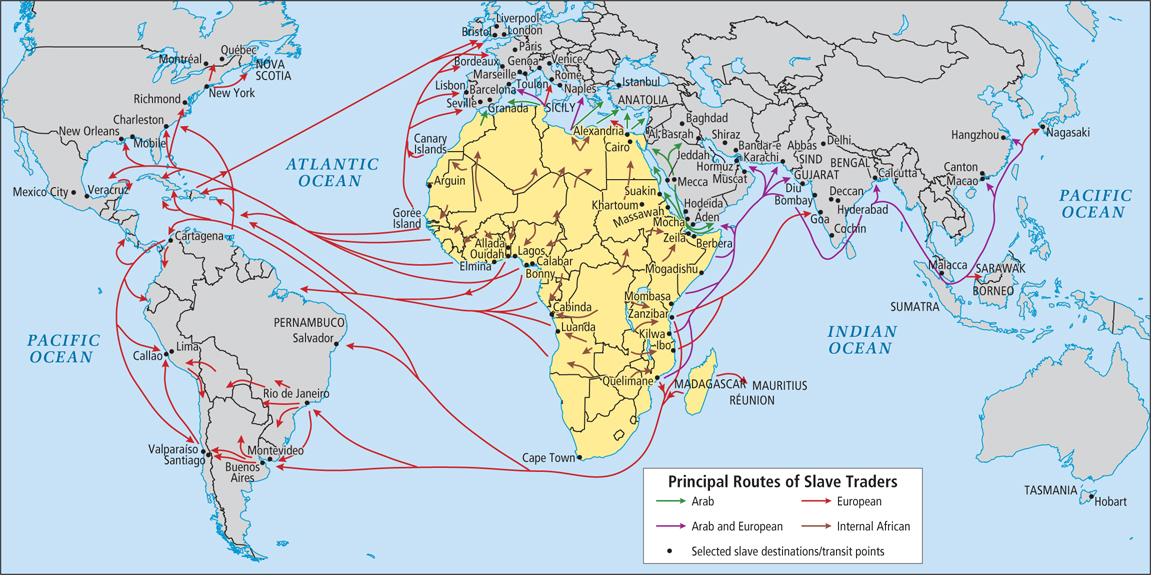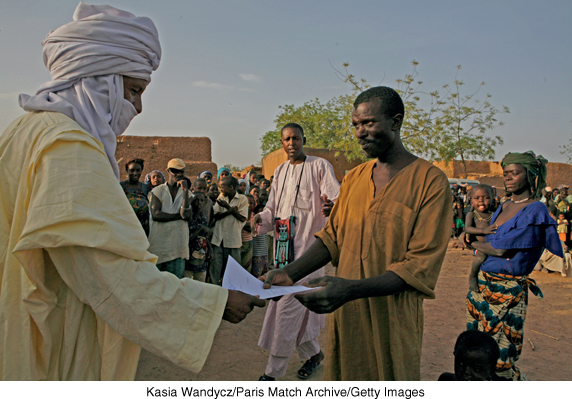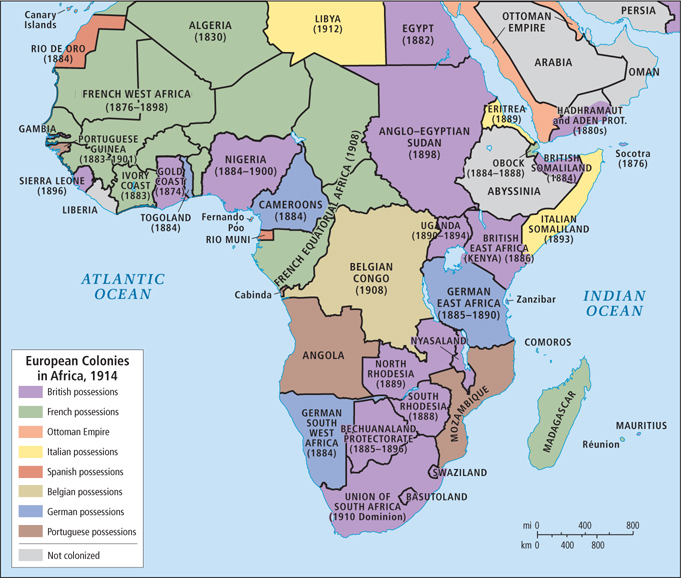7.3 HUMAN GEOGRAPHY
Africa’s rich and ancient history is often overshadowed by the dramatic changes that came with European colonialism, beginning about 600 years ago. These changes were so powerful that even today many countries are still struggling with the lingering effects of the colonial era.
7.3.1 HUMAN PATTERNS OVER TIME
Africa’s rich past has often been misunderstood and dismissed by people from outside the region. European slave traders and colonizers called Africa the Dark Continent and assumed it was a place where little of significance had occurred in human history. The substantial and elegantly planned cities of Benin in western Africa, Djenné in the Niger River basin, and Loango in the Congo Basin, which European explorers encountered in the 1500s, never became part of Europe’s image of Africa. Even today, most people outside the continent are unaware of Africa’s internal history or its contributions to world civilization, let alone its role in the emergence of humankind as a species.
The Peopling of Africa and Beyond
Africa is the original home of humans (Figure 7.11A). It was probably in eastern Africa (in what are today the highlands of Ethiopia, Kenya, and Uganda) that the first human species (Homo erectus) evolved more than 2 million years ago. Homo erectus differed anatomically from humans today. These early, tool-

THINKING GEOGRAPHICALLY
Use the Visual History above to answer these questions.
Scroll to see the full graphic.
Question 7.8
A What are the clues in the picture that food may have been a source of conflict between early humans and between humans and other animals?
Question 7.9
B Aside from the central fortlike structure, describe any further evidence of human habitation.
Question 7.10
C What does the existence of a mosque in Mali in 1327 indicate about the geography of trading patterns in this part of Africa?
Question 7.11
D What is the evidence of European involvement in the slave trade in this image?
Question 7.12
E What about this photo suggests hierarchies of status and power in British colonial Africa?
Question 7.13
F What about this stadium conveys the wealth and Westernization of South Africa?
Early Agriculture, Industry, and Trade in Africa
In Africa, people began to cultivate plants as far back as 7000 years ago in the Sahel and the highlands of present-
About 3400 years ago, people in the vicinity of Lake Victoria learned how to smelt iron and make steel. By 700 c.e., when Europe was still recovering from the collapse of the Roman Empire, a remarkable civilization with advanced agriculture, iron production, and gold-
Complex and varied social and economic systems existed in many parts of Africa well before the modern era. Several influential centers, made up of dozens of linked communities, developed in the forest and the savanna of the western Sahel. There, powerful kingdoms and empires rose and fell, such as Djenné; Ghana (700–
Africans also traded slaves. Long-

The course of African history shifted dramatically in the mid-
By the 1530s, the Portuguese had organized a slave trade with the Americas. The trading of slaves by the Portuguese, and then by the British, Dutch, and French, was more widespread and brutal than any trade of African slaves that preceded it. African slaves became part of the elaborate production systems supplying the raw materials and money that fueled Europe’s Industrial Revolution.
To acquire slaves, the Europeans established forts on Africa’s west coast and paid nearby African kingdoms with weapons, trade goods, and money to make slave raids into the interior. Some slaves were taken from enemy kingdoms in battle. Many more were kidnapped from their homes and villages in the forests and savannas. Most slaves traded to Europeans were male because they brought the highest prices and the raiding kingdoms preferred to keep captured women for their reproductive capabilities. Between 1600 and 1865, about 12 million captives were packed aboard cramped and filthy ships and sent to the Americas. One-
The European slave trade severely drained parts of Africa of human resources and set in motion a host of damaging social responses within Africa that even today are not completely understood (see Figure 7.11D). The trade enriched the African kingdoms that could successfully conquer their neighbors and impoverished or enslaved more peaceful or less powerful kingdoms. It also encouraged the slave-
Slavery persists in modern Africa and is a growing problem that some argue exceeds the transatlantic slave trade of the past. Today, slavery is most common in the Sahel region, where several countries have made the practice officially illegal only in the past few years (Figure 7.13). People may become enslaved during war. They may be sold by their parents or relatives to pay off debts or forced into slavery when migrating to find a job in a city. Some are even enslaved by gangsters in Europe, where they become street vendors, domestic servants, or prostitutes. In Côte d’Ivoire, Burkina Faso, and Nigeria, forced child labor is used increasingly in commercial agriculture such as cacao (chocolate) production. In Liberia, Sierra Leone, Cameroon, and Congo, young boys have been enslaved as miners and soldiers. It is hard to know exactly how many Africans are currently enslaved, but estimates range from several million to more than 10 million.

THINKING GEOGRAPHICALLY
Question 7.14
What does this photo suggest about the social relationships of the man being freed from slavery in Niger?
The Scramble to Colonize Africa
The European slave trade wound down by about the mid-
European colonial powers competed avidly for territory and resources, and by World War I, only two areas in Africa were still independent (Figure 7.14): Liberia on the west coast (populated by former slaves from the United States) and Ethiopia (then called Abyssinia) in East Africa. Ethiopia managed to defeat early Italian attempts to colonize it. Otto von Bismarck, the German chancellor who convened the 1884 Berlin Conference at which the competing European powers formalized the partitioning of Africa, revealed the common arrogant European attitude when he declared, “My map of Africa lies in Europe.” With some notable exceptions, the boundaries of most African countries today derive from the colonial boundaries set up between 1840 and 1916 by European administrators and diplomats to suit their purposes (see Figure 7.11E). These territorial divisions lie at the root of many of Africa’s current problems.

In some cases, the boundaries were purposely drawn to divide tribal groups and thus weaken them. In other cases, groups who used a wide range of environments over the course of a year were forced into smaller, less diverse lands or forced to settle down entirely, thus losing their traditional livelihoods. As access to resources shrank, hostilities between competing groups developed. Colonial officials often encouraged these hostilities, purposely replacing strong leaders with leaders who could be manipulated. Food production, which was the mainstay of most African economies until the colonial period, was discouraged in favor of activities that would support European industries: cash-
One of the main objectives of European colonial administrations in Africa, in addition to extracting as many raw materials as possible, was to create markets in Africa for European manufactured goods. The case of South Africa provides insights into the European expropriation of African lands and the subjugation of African peoples. In this case, these aims ultimately led to the infamous system of racial segregation known as apartheid (see the Case Study below).
apartheid a system of laws mandating racial segregation. South Africa was an apartheid state from 1948 until 1994
Power and Politics in the Aftermath of Independence
The era of formal European colonialism in Africa was relatively short. In most places, it lasted for about 80 years, from roughly the 1880s to the 1960s. In 1957, Ghana became the first sub-
Africa entered the twenty-
For many years and with few exceptions, governments continued to mimic the colonial bureaucratic structures and policies that distanced them from their citizens. Corruption and abuse of power by bureaucrats, politicians, and wealthy elites stifled individual initiative, civil society, and entrepreneurialism, creating instead frustration and suspicion. Too often, coups d’état were used to change governments. Democracy, where it existed, was often weakly connected only to voting and not to true participation in policy making at the community, regional, and national levels.
Even today African policy makers, like their colonial predecessors, are often insensitive to the widespread poverty and hardship around them. This was demonstrated during the summer of 2010 when South Africa hosted the 2010 World Cup, the world’s largest sporting event and a first for this region, which up to that point had never hosted a global sporting event of similar scale. The preparations involved demolishing the homes of tens of thousands of poor, urban residents who were relocated to make way for the elegant new soccer stadiums (see Figure 7.11F). More recently, in an August 2012 crackdown reminiscent of those under apartheid, police shot dead 34 miners during a strike at a platinum mine in Marikana in Northwest Province. (More strikes followed.)
Other relics of the colonial era can be seen in the dependence of African economies on relatively expensive imported food and manufactured goods as well as on the production of agricultural and mineral raw materials for which profit margins are low and prices on the global market highly unstable. Many sub-
CASE STUDY
The Colonization of South Africa
The Cape of Good Hope is a rocky peninsula that shelters a harbor on the southwestern coast of South Africa. Portuguese navigators seeking a sea route to Asia first rounded the Cape in 1488. The Portuguese remained in nominal control of the Cape until the 1650s, when the Dutch took possession with the intention of establishing settlements. Dutch farmers, called Boers, expanded into the interior, bringing with them herding and farming techniques that used large tracts of land and depended on the labor of enslaved Africans. The British were also interested in the wealth of South Africa, and in 1795, they seized control of areas around the Cape of Good Hope. When slavery was outlawed throughout the British Empire in 1834, large numbers of slave-
In the 1860s, extremely rich deposits of diamonds and gold were unearthed in these areas, securing the Boers’ economic future. African men were forced to work in the diamond and gold mines for minimal wages under extreme hardship and unsafe conditions. They lived in unsanitary compounds that travelers of the time compared to large cages.
Britain, eager to claim the wealth of the mines, invaded the Orange Free State and the Transvaal in 1899, waging the Boer War. This brutal war briefly gave the British control of the mines until resistance by Boer nationalists forced the British to grant independence to South Africa in 1910. This independence, however, applied to only a small minority of whites: the Boers (who have since been known as Afrikaners) and some British people who chose to remain. Not until 1994 would full political rights (voting, freedom of expression, freedom of assembly, freedom to live where one chose) be extended to black South Africans—
In 1948, the long-

The African National Congress (ANC) was the first and most important organization that fought to end racial discrimination in South Africa. Formed in 1912 to work nonviolently for civil rights for all South Africans, the ANC grew into a movement with millions of supporters, most of them black, but some of them white. Its members endured decades of brutal repression by the white minority. One of the most famous members to be imprisoned was Nelson Mandela, a prominent ANC leader, who was jailed for 27 years and finally released in 1990.
Violence increased throughout South Africa until the late 1980s, when it threatened to engulf the country in civil war. The difficulties of maintaining order, combined with international political and economic pressure, forced the white-
THINGS TO REMEMBER
Anatomically modern humans (Homo sapiens) evolved from earlier hominoids in eastern Africa about 250,000 years ago. By about 90,000 years ago, Homo sapiens had reached the eastern Mediterranean. They joined and eventually replaced other hominid species from Africa that had migrated throughout Eurasia starting 1.8 million years ago.
Agriculture, industry, and international trade have an early history in Africa; agriculture began as early as 7000 years ago in northeast sub-
Sahara; iron smelting 3400 years ago; and trade extended across the Indian Ocean to Asia long before Europeans came to east Africa. Slavery was practiced in Africa within several powerful kingdoms, and then pre-
Islam Arab traders extended the custom around the Mediterranean and to Asia. Muslims continued the practice. The European slave trade to the Americas severely drained the African interior of human resources and set in motion a host of damaging social responses within Africa. Slavery persists in parts of modern Africa. The main objectives of European colonial administrations in Africa were to extract as many raw materials as possible; to create markets in Africa for European manufactured goods and food exports; and to divide and conquer by splitting powerful ethnic groups or by placing groups hostile to one another under the same jurisdiction, governed by complicit indigenous leaders.
During the era of European colonialism, sub-
Saharan Africa’s massive wealth of human talent and natural resources flowed out of Africa. Even after the countries of the region became politically independent, wealth continued to flow out of Africa because of fraud and unfavorable terms of trade. South Africa trod a rocky road through colonial oppression and apartheid to its present relatively precarious position as the wealthiest country in sub-
Saharan Africa. Governments have continued to mimic colonial policies, including corruption, in ways that have kept sub-
Saharan African countries economically dependent into the twenty- first century. This has stiffed individual initiative, civil society, and entrepreneurialism. Political freedoms are often poorly protected.